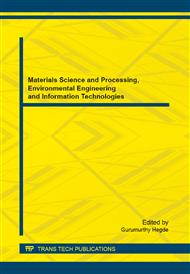[1]
T. M. Oliver, K. Jugoslav, P. Aleksandar, et al, Synthetic activated carbons for the removal of hydrogen cyanide from air, J. Chemical Engineering and Processing. 44 (2005) 1181-1187.
DOI: 10.1016/j.cep.2005.03.003
Google Scholar
[2]
P. Ning , J. Qiu , X. Q. Wang , et al, Metal loaded zeolite adsorbents for hydrogen cyanide removal, J. Journal of Environmental Sciences. 25 (2013) 808-814.
DOI: 10.1016/s1001-0742(12)60138-7
Google Scholar
[3]
Z. Chen, S. Yuan, Q. F. Liang, et al, Distribution of HCN, NH3, NO, and N2 in an entrained flow gasifier, J. Chemical Engineering Journal. 348 (2009) 312-318.
DOI: 10.1016/j.cej.2008.08.038
Google Scholar
[4]
S. Yuan, J. Z. Zhou, J. Li, et al, HCN and NH3(NOx precureors) released under rapid pyrolysis of biomass/coal blends, J. Journal of Analytical and Applied Pyrolysis. 92 (2011) 463-469.
DOI: 10.1016/j.jaap.2011.08.010
Google Scholar
[5]
P. W. Ye, Z. Q. Luan, Q. Li, et al, The use of a combination of activated carbon and nickel microfibers in the removal of hydrogen cyanide from air, J. CARBON. 47 (2009) 1799-1805.
DOI: 10.1016/j.carbon.2009.02.031
Google Scholar
[6]
J. W. Zhang, T. ITO, T. Okada, et al, Improvement of NOx formation model for pulverized coal combustion by increasing oxidation rate of HCN, J. Fuel. 113 (2013) 697-06.
DOI: 10.1016/j.fuel.2013.06.030
Google Scholar
[7]
M. Y. Xu , Y. P. Cui, L. L. Qin, et al, Key factors influencing the release and formation of HCN during pyrolysis of iron-containing coal, J. Journal of Fuel Chemistry and Technology. 35 (2007) 5-7.
DOI: 10.1016/s1872-5813(07)60008-5
Google Scholar
[8]
J. Fuente, M. Ruiz-Bermejob, S. Menor-Salvan, Thermal characterization of HCN polymers by TGeMS, TG, DTA and DSC methods, J. Polymer Degradation and Stability. 96 (2011) 943-948.
DOI: 10.1016/j.polymdegradstab.2011.01.033
Google Scholar
[9]
M. Seredych, M. V. Merwe, T. J. Bandosz, Effects of surface chemistry on the reactive adsorption of hydrogen cyanide on activated carbons, J. CARBON. 47 (2009) 2456-2465.
DOI: 10.1016/j.carbon.2009.04.037
Google Scholar
[10]
H. L. Karlsson, Ammonia, Nitrous oxide and hydrogen cyanide emissions from five passenger vehicles, J. Science of the Total Evironment. 334 (2004) : 125-132.
DOI: 10.1016/j.scitotenv.2004.04.061
Google Scholar
[11]
M. J. Hudson, J. P. Knowles, P. J. Harris, et al, The trapping and decomposition of toxic gases such as hydrogen cyanide using modified mesoporous silicates, J. Microporous and Mesoporous Materials. 75 (2004) 121-128.
DOI: 10.1016/j.micromeso.2004.07.023
Google Scholar
[12]
Z. W. Sun, Z. S. Li, A. A. Konnov, et al, Quantitative HCN measurements in CH4/N2O/O2/N2 ames using mid-infrared polarization spectroscopy, J. Combustion and Flame. 158 (2011) 1898-(1904).
DOI: 10.1016/j.combustflame.2011.03.008
Google Scholar
[13]
K. Hansson, J. Samuelsson, C. Tullin, et al, Formation of HNCO, HCN, and NH3 from the pyrolysis of bark and nitrogen-containing model compounds, J. Combustion and Flame. 137 (2004) 265-277.
DOI: 10.1016/j.combustflame.2004.01.005
Google Scholar
[14]
O. Krocher, M. Elsener, Hydrolysis and oxidation of gaseous HCN over heterogeneous catalysts, J. Applied Catalysis B: Environmental. 92 (2009) 75-89.
DOI: 10.1016/j.apcatb.2009.07.021
Google Scholar
[15]
H. B. Zhao, G. Tonkyn R, E. Stepphan, et al, Catalytic oxidation of HCN over a 0. 5% Pt/Al2O3catalyst, J. Applied Catalysis B: Environmental. 65 (2006) 282-290.
DOI: 10.1016/j.apcatb.2006.02.009
Google Scholar
[16]
J. Gimnez-Lopez, A. Millera, R. Bilbao, et al, HCN oxidation in an O2/CO2 atmosphere: An experimental and kinetic modeling study, J. Combustion and Flame. 157 (2010) 267-276.
DOI: 10.1016/j.combustflame.2009.07.016
Google Scholar


